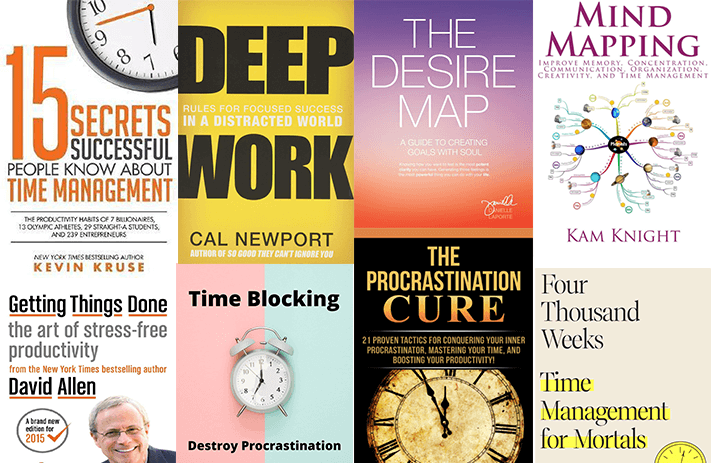
Click the button to start reading
Getting Time on Your Side: The Best Books on Time Management
Do you know that “time” is the most commonly used word in the English language? It makes sense. Every time we converse, make plans, or look over our day, our questions revolve around time.
Do you have the time? How long will this take? Are you running late? Do you have a minute?
The biggest question we all seek to answer around time is: Do I have enough time?
Because we all have the same 1,440 minutes each day and 168 hours each week–and nearly all of us can improve how we relate to them.
Maybe you’re sick with regret, as for the second time this month, you’ve missed a flight or arrived late for an appointment, simply because you let time get away from you. Or you’re completely burnt out from working non-stop, yet completing things never brings any peace of mind. Or you’re guilt-ridden, as whenever you look around the house, you see dozens of things to do–so many, in fact, you can’t muster the will to begin any single one.
Maybe you feel torn and frustrated, as everyone wants your time; your friends, your boss, your spouse, your kids. And all you want is some time to kick back, put up your feet and feel respite from the grind.
Sometimes those 1,440 minutes feel more like a tumbleweed, rolling across a prairie, laughing at us as it bobs and blows just beyond our grasp. Or those 168 hours feel like getting onto a half-broke horse. It neighs, bucks, turns and pulls us in all directions, and we have no choice but to climb back on, day after day.
We all know how we would like to relate to the hours and minutes of our day. We want a routine that allows us to produce consistent quality work, a lifestyle with plenty of time for family and leisure, and a calm disposition, with respite from the frenzied feeling of having too much to do.
But how do you tame something so uncontrollable and independent as time?
It’s not an easy question to lasso and get your head around. But fortunately it’s been written about at great length. According to some, making small changes is the solution. Compounded over time, these routines determine who we become. To others, aligning our daily lives with our core values brings continuity to our routines. Others advocate capturing to-dos with a list. Still others believe in escaping from our time-is-money paradigm altogether, and returning to a time when all work stopped with the set of sun.
With every answer, the objective is the same: developing a relationship with time that unleashes our potential and secures our peace of mind. Let’s peruse some books to read on time management and discover some great methods, ideas and time management tips to incorporate into our daily lives.
15 Secrets Successful People Know About Time Management: The Productivity Habits of 7 Billionaires, 13 Olympic Athletes, 29 Straight-A Students and 239 Entrepreneurs by Kevin Kruse
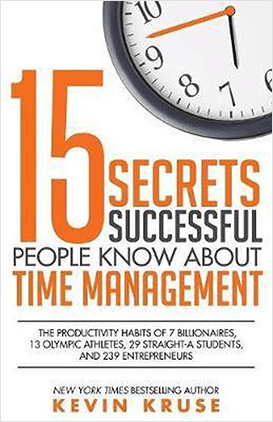 Publisher: The Kruse Group
Publisher: The Kruse Group
Year Published: 2015
Number of Pages: 202
If someone asked you what the most important thing in your life was, what would you say?
According to Kevin Kruse, author of 15 Secrets Successful People Know About Time Management, the correct answer to this question is “time.”
Why is time so important? Because unlike everything else in your life, including money, a job and even a spouse (he asserts), you can’t get it back. But time “is irreplaceable. Once it’s gone, it’s gone for good.”
Kruse has interviewed hundreds of successful people for this book, including Sheryl Sandberg, Marissa Mayer and Jack Dorsey, and shares the common themes he’s gleaned from them.
“Highly successful people don’t think about time much at all. Instead, they think about values, priorities, and consistent habits.”
“The single most important thing when it comes to time and productivity isn’t a tactic or a trick—it’s a shift in mindset.”
He recommends identifying priorities, then creating systems around them. The first step is identifying your MIT, or most important thing. Next, create a habit of dedicating the first two hours of your day to your MIT, because that’s when your cognitive powers are the sharpest.
A great schedule (not a list, he makes clear) releases stress, as it creates a slot for all your priorities. Anything on the schedule is treated like an appointment with the dentist. It’s not shifted around or cut short.
Kruse doesn’t waste his readers’ time with 15 Secrets. In only 200 pages, he covers a lot, including sections titled: Procrastination Cure, How to Leave the Office by 5:00, Master Your Email, and Meeting Hacks. It’s written in first person and includes many personal anecdotes.
It’s helpful for people with all sorts of lifestyles. He ends each section by clarifying how his lessons apply if you’re an entrepreneur, a stay at home parent, a student, a freelancer and an executive.
Kruse is a prolific writer. He’s contributed over 100 articles to Forbes, and has written the books Employee Engagement 2.0 and Unlimited Clients. Readers find his style and voice relatable, and his presentation in 15 Secrets upbeat and fun.
Four Thousand Weeks: Time Management for Mortals by Oliver Burkeman
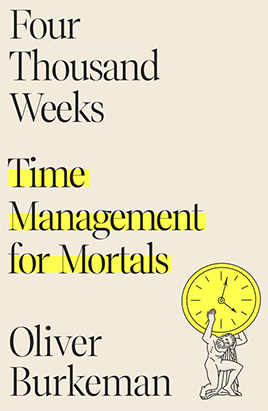 Publisher: Farrar Straus and Giroux
Publisher: Farrar Straus and Giroux
Year Published: 2021
Number of Pages: 288
Four Thousand Weeks touches on this notion of “living versus existing.”
Its British author, Oliver Burkeman, notes that in modern society, we regard time like it’s a resource, the same way we regard water, food and money. Assuming we live into our 70s, our entire life, then, can be codified, valued, sized up and measured into around four thousand weeks.
He contrasts this attitude with peasants in pre-industrial England, where there was no clock hanging on the wall or daily planners at anyone’s desk. The seasons determined daily tasks, and the sunset determined when one fell asleep at the end of the day.
He ventures that our modern approach to time robs us of our peace of mind. When time is seen as a scarce resource, we’re haggling ourselves over whether we’ve spent it wisely. This leaves us feeling chronically dissatisfied after a hard day’s work.
This book is helpful for someone who never finds any satisfaction for a job well done, or who’s guilt-ridden for mis-managing time. He asserts that removing ourselves from a treadmill-approach to life makes us more productive in the long-term.
Burkeman presents methods for developing a healthy relationship with time, drawing on lessons from psychologists, philosophers, and spiritual teachers, “all who rejected the struggle to dominate or master [time].”
He also discusses a concept called “deep time,” which is similar to timelessness. In deep time, we forget about the treadmill and the ticking clock. “The boundary separating the self from the rest of reality grows blurry, and time stands still.” Deep time is the realm of prayer and contemplation, “a realm where there is enough of everything, where we are not trying to fill a void in ourselves and the world.”
In Four Thousand Weeks, Burkeman evaluates modern lifestyles through the lens of a historian. Chapters include “The Loneliness of the Digital Nomad” and “Becoming a Better Procrastinator.”
Readers have found that the themes and ideas in the book flow naturally, and that it’s a substantive self-help book.
Burkeman also writes a blog and a column for The Guardian called “This Column Will Change Your Life.”
The Procrastination Cure: 21 Proven Tactics for Conquering Your Inner Procrastinator, Mastering Your Time, and Boosting Your Productivity! by Damon Zahariades
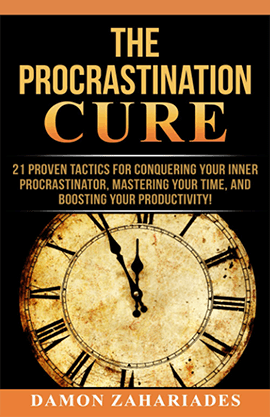 Publisher: Art of Productivity
Publisher: Art of Productivity
Year Published: 2017
Number of Pages: 166
Procrastination is a bit of a conundrum. For example, why do we put off something so simple as paying a bill? All it entails is either making a few clicks on the computer or putting a stamp onto an envelope then walking to the mailbox.
“We tend to pursue what is easiest and most likely to deliver immediate gratification, even if doing so is inconsistent with our long-term goals,” Damon Zaharaides writes in The Procrastination Cure.
He writes this book for the dilly-dallier, the chronic procrastinator, the person who can put off a boring task even when the stakes are high. To some extent, this is all of us.
Zahariades stresses that procrastination is a fact of life. We’ll never entirely recover, but his book aims to decrease procrastination tendencies and so “increase productivity, and better manage your time.”
A procrastinator not only pays practical consequences, but emotional ones as well: he lives with the guilt and angst that comes from putting off necessary tasks. The Procrastination Cure is about creating emotional well-being through living a responsible, productive lifestyle.
“Taking action causes the discomfort and guilt associated with procrastination to evaporate. It also erases the stress and worry of doing the task. And just as importantly, it gives us the momentum we need to continue working until the task has been completed.”
The book is well organized. It begins with a simple definition of procrastination, then covers Zahariades’ personal history as a chronic procrastinator, paying car tabs after they’re due (and getting his car towed), ending relationships way too late and turning projects in way past their deadline.
Then he provides reasons why we procrastinate (“Fear of Failure,” “Fear of Success,” “Feelings of Overwhelm,” “Laziness,” “Inability to Make Decisions”) and finishes with 21 tactics for overcoming procrastination, including “Eat the Frog,” “Reward Yourself,” “Ask Others to Set Deadlines,” “Take Small Steps” and “Get Rid of Distractions.”
Zahariades runs a content marketing agency, and has a blog called the “Art of Productivity.” Readers say the book provides motivating tips that really work; Netflix is getting shut off, the sock drawers are getting organized and the lawn is getting mowed.
The Checklist Manifesto: How to Get Things Right by Atul Gawande
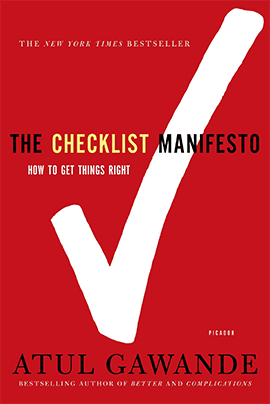 Publisher: Picador
Publisher: Picador
Year Published: 2011
Number of Pages: 240
We’re living in a complex world. Even an everyday activity like going to the gym entails collecting at least fifteen items into a duffel bag. How many times have you gotten to the car, put the gym bag in the back seat and then returned to the house to retrieve a forgotten water bottle or towel?
The bestseller Checklist Manifesto promises to be a powerful antidote to the complexity we face in our everyday lives.
In the book, surgeon and author Atul Gawande recounts numerous anecdotes he’s heard over the years from colleagues overlooking “small” details in what otherwise is an earnest effort to treat a patient.
In one anecdote, a man shows up at the Emergency Room with a stab wound. “Everyone involved got almost every step right…except no one remembered to ask the patient or the emergency medical technicians what the weapon was.” As it turns out, the weapon was a bayonet, and due to this lack of knowledge, the patient nearly died.
In the modern world, Gawande argues, the cause of failure is more commonly due to ineptitude than ignorance. We know what we need to do, but things are so complex that we fail to capture and execute on all the details.
The checklist, he proposes, captures all of the requirements in a project, a task or a routine and keeps them front of mind. It is a system that applies to all areas of our lives.
The Checklist Manifesto is for anyone who feels overwhelmed or suffers from “brain clog.” Creating a list for everyday things such as what to pack for a weekend trip, a camping vacation or a session at the gym reduces brain clutter and keeps us from thinking too hard about any one thing.
Gawande is a surgeon working in Boston, a staff writer at The New Yorker and the author of another bestseller, Complications.
Readers find the stories in Checklist Manifesto gripping, even for someone with no medical background.
Atomic Habits: An Easy & Proven Way to Build Good Habits & Break Bad Ones by James Clear
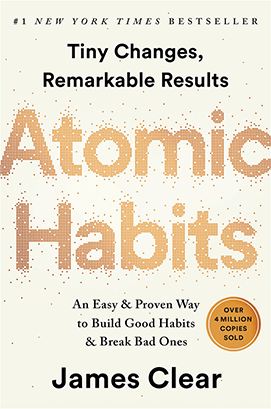 Publisher: Avery
Publisher: Avery
Year Published: 2018
Number of Pages: 320
Brushing your teeth every night is such a tiny action. It only takes a few minutes. Yet, looking over the span of thirty or more years, imagine the consequences of not doing it. By the age of 60 or 70 you may well be removing a set of false teeth from your mouth at the end of each day.
James Clear’s book, Atomic Habits, is all about the impact of small actions like teeth brushing. He makes a comparison between small habits and compounding interest, claiming that a small lifestyle change, compounded over time, completely alters the course of your life.
“Improving by 1 percent isn’t particularly notable—sometimes it isn’t even noticeable—but it can be far more meaningful, especially in the long run.”
His message is heartening to someone who struggles with time management or procrastination. The remedy isn’t changing your lifestyle by 180 degrees. Rather, a tiny change has enormous long-term repercussions.
Something like routinely leaving work thirty minutes early in order to eat dinner with the family doesn’t seem like a big deal in the day-to-day. Over the span of a decade, however, that’s a huge chunk of quality family time. Or, spending thirty minutes each weekend decluttering the garage may look insignificant at first, but it starts to make a huge impact after a whole year.
“A slight change in your daily habits can guide your life to a very different destination,” writes Clear.
This “small strokes fell great oaks” message works both ways. Habits like negative thoughts, stress and outrage compound into real effects with consequences that we live with.
Changes don’t happen linearly as we’d expect, Clear points out. Rather, like compounding interest, the effects accumulate slowly, and then at some distant future date, we cash in on our habits.
Clear writes the book in five parts, with chapters such as “The Truth About Talent,” “Walk Slowly, but Never Backward” and “The Secret to Self Control.” It’s easy to read, with plenty of stories and graphs to communicate his compounding message.
Atomic Habits is a bestselling book that’s sold over 5 million copies. Clear speaks to Fortune 500 companies on habits and decision marketing and sends out a “3-2-1” newsletter to a million subscribers.
Readers find Atomic Habits informative, if somewhat redundant.
The Desire Map: A Guide to Creating Goals by Danielle LaPorte
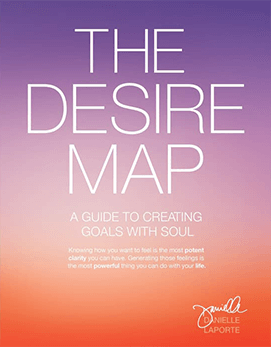 Publisher: Sound True
Publisher: Sound True
Year Published: 2014
Number of Pages: 288
Desire Map is for people who’ve set goals and stayed on track to achieve them, only to arrive at the finish line disappointed. They experience no satisfactory emotional payoff.
In order to avert this disappointment, author Danielle LaPorte proposes we establish goals around the emotions we want to experience and feel in our lives, and then build out our daily routines in pursuit of these emotions.
Her method isn’t about setting concrete goals such as taking a vacation or earning a certain income. “Four feelings. Stuck in my Day-Timer. Referred to every day. Guiding my choices,” she writes.
Her system often leads to paradigm shifts in people’s lives, she warns. “So when you get clear on how you actually want to feel, your life-planning process might get turned upside down.”
When readers realize their current track leads to dead-end emotions, they end up in new careers, or find new approaches to things like budgeting.
Desire Map is helpful for someone who feels trapped in a web of “shoulds.” It’s about aligning all of a person’s precious time with her core desires.
It consists of two books: The Theory and The Workbook, with chapters like “Recalibrating the Compass” and “The Benefits of Clear Desires.” She’s also included action sheets to keep goals on track, including monthly and weekly check-ins.
The book reads like online content, which makes sense as LaPorte’s home turf is the internet. The san-serif text changes size frequently. Huge all-cap text and bold text intermingles with the regular-sized text throughout the pages of her book.
Readers love LaPorte for her energy, and believe she’s brought a lot of herself to this book, and that it includes thoughtful details.
LaPorte has an eponymous website that’s been named by Forbes as one of the top 100 websites for women, where she dispenses life and business advice. Her charismatic online presence has amassed an enormous social media following. She also wrote The Fire Starter Sessions.
Deep Work: Rules for Focused Success in a Distracted World by Cal Newport
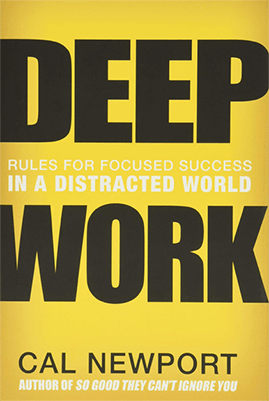 Publisher: Grand Central Publishing
Publisher: Grand Central Publishing
Year Published: 2016
Number of Pages: 304
Sometimes we may have a solid two hours for a task, yet it barely reaches the finish line even so. Too many “Ya got a minute?” knocks at the office door results in a sloppy deliverable that’s not at all representative of our best work.
According to Cal Newport, author of Deep Work, this level of performance won’t cut it in the current economy. As robots swoop in to replace labor, only highly skilled employees can retain their positions.
Performing at a skilled, elite level requires what he calls “deep work.” Deep work is a method for improving output that maximizes the cognitive value of your brain, and requires “distraction-free concentration.” He contrasts deep work from shallow work, which includes things like sorting papers and answering emails.
Deep Work takes a refreshing spin on time management, as it’s about how to improve the quality of work time, rather than how to structure a workday. It provides specific instructions on how to create an environment to produce exceptional work.
Newport illustrates the concept of deep work with the story of Nate Silver, who in 2008 garnered praise for predicting the presidential outcome by using a thorough analysis of polling data. Using the same “deep work” method, Silver’s gone on to predict things like the recipients of Oscars at the Academy Awards.
Even at the book’s 2016 publication date, the Nate Silver story sounds dated, especially since “deep work” is a cutting-edge phenomenon. Chapters in Deep Work include no-brainers such as “Quit Social Media.”
But the book was a bestseller nonetheless. Newport is a Georgetown professor, and author of other bestsellers, including Digital Minimalism and A World Without Email. He hosts the podcast “Deep Questions” and speaks regularly on NPR.
Readers have noted the concepts presented in deep work have been around for some time. Finding a quiet place to work and eliminating distractions is common sense. And producing high-quality work isn’t a cutting edge notion. It’s been a requirement in several professions for some time now.
Time Blocking: Destroy Procrastination, Get More Done, and Feel Great About It by Abe Wood
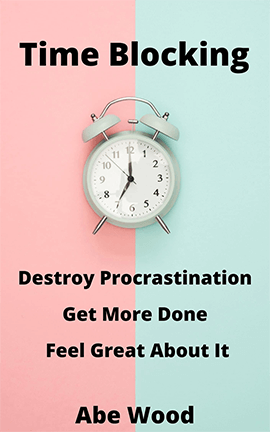 Publisher: Thomas Steel
Publisher: Thomas Steel
Year Published: 2021
Number of Pages: 47
You know in the movies when the camera focuses on one person’s face, and everything in the background goes fuzzy?
Time blocking is like this. It’s when you focus on one activity for an hour or two, and let everything else around you “go fuzzy.” It’s also known as batching, boxing and chunking.
In his book Time Blocking, author Abe Wood believes time blocking is the key to insane productivity. Sometimes we only have an hour to dedicate to an important task. Time blocking is about maximizing the productivity of that hour.
“The idea of time blocking is to pre-plan your day before it arrives…before you go to sleep, you’ll spend a bit of time creating a plan for the next day. Then, when you wake up, you’ll immediately know what you need to get started on.”
The book has two parts, and includes the chapters “Unload and Free Your Brain,” “Don’t Be a Tyrant with Yourself,” “The Elon Musk Method” and “The Cal Newport Method.”
Readers have appreciated that Wood has packed some great lessons into his quick book. At under 50 pages, you can read Time Blocking in an afternoon, and start applying his lessons the following day!
Getting Things Done: The Art of Stress-Free Productivity by David Allen
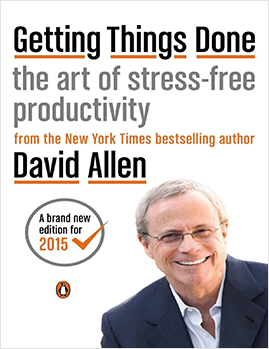 Publisher: Penguin Books
Publisher: Penguin Books
Year Published: 2015
Number of Pages: 352
Are you ever so overwhelmed with everything to do that you can’t even focus on the task at hand? David Allen aims to tackle this problem in his book, Getting Things Done.
He addresses his book both to professionals and non-professionals and his goal is to remove stress and anxiety from people’s work and day-to-day lives.
“This book is not so much concerned with getting things done as it is championing appropriate engagement with your world—guiding you to make the best choice of what to do in each moment, and to eliminate distraction and stress about what you’re not doing.”
It’s a practice, a method, a set of habits that one develops, and he presents both the principles behind it and then the ingredients for practicing it.
“The behavioral ingredients of GTC are…to write something down, decide what the next step is to move forward, record the reminder of that on a list, and review the list.”
The book is structured to present the principles behind his “GTC Method,” then its components, and finally the ingredients to put his method into practice. “Capturing” is central to the method. This essentially entails outlining all of the tasks or components of a process, project or routine.
This is the second edition of Getting Things Done. Allen updated the 2001 version to keep pace with technology.
Allen is a coach to CEOs and business leaders. He’s trademarked his GTD method. It works for anyone, including students, parents and executives. He’s also written Ready for Anything: 52 Productivity Principles for Work and Life.
Some readers really stand by the method, calling it a game-changer and saying it helps them de-clog their brain, while others find it’s a dressed up version of a checklist.
Mind Mapping: Improve Memory, Concentration, Communication, Organization, Creativity, and Time Management (Mental Performance) by Kam Knight
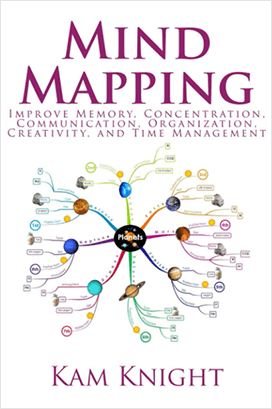 Publisher: MindLily
Publisher: MindLily
Year Published: 2012
Number of Pages: 209
We all know how it feels to get drawn into a long, stream of consciousness conversation with someone, where one thing leads to another then another, down the rabbit hole until you have no idea where you started.
This is a little how our brain works, Kam Knight asserts in his book, Mind Mapping. Whenever we encounter a certain smell, for example, our brain makes all sorts of associations with the other times we encountered the smell, going all the way back to early childhood.
And it’s part of the power behind mind mapping. The mind map visually represents what’s going on in our brains. It helps to process complex information and is applicable with all learning styles: verbal, auditory and kinesthetic.
How does mind mapping assist with time management? It’s a powerful tool for organizing ideas, planning a project or capturing requirements.
If you’ve managed a project in the past and certain areas became disaster zones, try mind mapping this time around. For example, a mind map created around costs and responsibilities can help identify known unknowns and minimize scope creep.
In the book, Knight explains how mind mapping is helpful in daily life, with creating things like chore lists and daily schedules.
Knight is a coach who’s written extensively on productivity and time management. He’s also written the book, Speed Reading: Learn to Read a 200+ Page Book in 1 Hour.
Readers find Mind Mapping comprehensive, as it explains how to make mind maps, why they work, and what to use them for. They also stress that mind mapping is a practice that needs to be developed.
Conclusion
The great books on time management cover a lot of ground. We’ve heard from the pragmatists who believe that time is money, and staying afloat means maximizing the output of every hour of every day, the visionary who wants us to align our schedules not around concrete goals but desired emotions, and the philosopher who advocate stepping out of the modern time-as-a-resource realm and thinking like a peasant.
The authors advocate eating the frog, using time blocking, writing checklists, creating goals, developing systems and routines, removing distractions, creating space to produce exceptional work, and even detaching from the time space realm to experience timelessness.
Taking this all in at once feels pretty overwhelming. And it may easily leave us worried that we can’t possibly solve our problems with time management. The clock will strike midnight, the spell will end, and we’ll return to a state of helplessness: routines of chronic stress, procrastination, and never-ending work.
But whenever you think that time management is about magic, just pare things down to the basics. Time management is about systems and routines. It’s about capturing to-dos. Most fundamentally, it’s about being productive while achieving peace of mind.
So, when you have days where everything takes too long and a project is moving at glacial speed, take a moment to step back. Seek to align yourself with the emotions you want to feel, not the ones you’re experiencing. Recall that changes don’t happen in a moment. And even, if you can, escape to a period of timelessness. Shut off the computer and the alarms, and set your head down with the set of sun.

